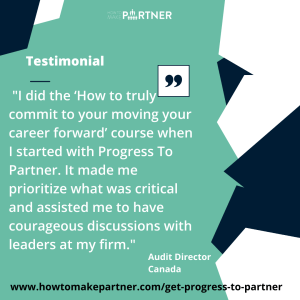Want to know how to embrace change in the workplace? Embracing change is one of the most important skills to have in this fast-paced, rapidly changing world. It’s not easy though, as we all like to do things our own way and resist outside influence or advice from others. As you can imagine, this is why we find it difficult to get out of our comfort zones and embrace change AND to then lead this change and get our teams to accept it too. Although it’s difficult, accepting change is essential to move forward and into the future, especially in law, accounting, and consulting firms. Here is how to embrace change in the workplace and how to get your team to accept this change too.
** This article is an extract from the my Course, “Leading yourself and others through change.” See what’s included in the full course at the end of this article and join Progress to Partner Academy to get access to all 14 of our courses.
How to embrace change using emotional intelligence (3 hacks!)
When it comes to change, whether it’s implementing a new system or trying to focus more on business development, in order to be successful, we need the right mindset, a support team, and communication. If one of these crucial pillars is lacking, then change won’t happen! Why? Because we are creatures of habit and find comfort in sticking to our status quo. To implement change, both you and your team need to embrace the future and all that it holds. Here’s how to do that.
1. You need to lead by example first
 If you’re going to introduce a change in the workplace, you need to wrap your head around it first before you can communicate this to your team. After all, before we can lead others through change, we need to lead ourselves first. We are no good to anyone if we are personally not behind the change, so your first port of call should be to hack your own brain to embrace it. A good way to do this is to change your mindset. Think about what you get out of this change? OR, what’s in it for you if you can be a great self-leader during change? For example:
If you’re going to introduce a change in the workplace, you need to wrap your head around it first before you can communicate this to your team. After all, before we can lead others through change, we need to lead ourselves first. We are no good to anyone if we are personally not behind the change, so your first port of call should be to hack your own brain to embrace it. A good way to do this is to change your mindset. Think about what you get out of this change? OR, what’s in it for you if you can be a great self-leader during change? For example:
1. There’s always going to be change, so why not learn to lead well now?
Technology changes, life changes and the pace of change is never going to slow down. You’ll have to learn to get used to it.
2. Teams are more effective when they respond positively to change.
Creating and maintaining a high performing team means they need to keep up with change and mentally cope with it. High performing teams are also empowered to identify and initiate change to improve working practices!
3. Facilitating and leading change is a must-have skill set.
Partnership competency models always include leading self and others through change. By being successful in this area you will not only meet these requirements but are also more likely to deliver strong financial results and cultural changes that are also part of partnership competencies looked for by firms.
4. Your own well-being will benefit from less stress!
Change is often hard and can have a toll on your mental and physical well being. Becoming a great self leader during change helps reduce the negative impact on your wellbeing.
2. Communicate the change to your team in the right way
![]() Getting communications right is a key part of successful change. Why? Because communication is essential, from creating successful teams to developing a strong pipeline, and leading change successfully is no different. Once you know how to embrace change yourself, it’s time to communicate it to your team. Classic mistakes that prevent lawyers, accountants, and consultants from implementing change successfully ALL trace back to communication. Often, what happens is:
Getting communications right is a key part of successful change. Why? Because communication is essential, from creating successful teams to developing a strong pipeline, and leading change successfully is no different. Once you know how to embrace change yourself, it’s time to communicate it to your team. Classic mistakes that prevent lawyers, accountants, and consultants from implementing change successfully ALL trace back to communication. Often, what happens is:
- Change is only communicated at the point where it needs to be implemented – this doesn’t give people time to digest and get used to this change.
- The right people aren’t involved early enough in the process – for example, if you’re changing the billing process and not involving your secretaries early enough, you won’t know their specific challenges and you’re missing the opportunity for them to become champions of those changes.
- The vision (shared purpose) is not clearly communicated – the impact and/or success of the change is reduced because the team doesn’t understand how this change links to the overall purpose.
- Communication is at a firm level and not tailored for teams and individuals – this directly impacts the success of the change because it is not the firm or even managers that implement the change, it’s the individual employees. They are the ones who need to change their habits and behaviours for this to be successful, so they need specific communication and support.
- Insufficient time is dedicated to training and support to implement and embed the change – with no training or last-minute training, the change isn’t going to have the impact that it could.
If you want to know how to embrace change in the workplace (and how to get your team on board so you can all implement it successfully), you need to communicate in the right way. You need to communicate early enough, share the overall vision with your team, identify the “what’s in it for me?” for every team member, tailor the communication to each person, and give them enough training and support to give them the best chance of success! As the first or second-line manager, it is your responsibility to do that; to help your team implement this change.  Note to Progress to Partner members: You can find out more about How to effectively communicate with your team in the “How to build a strong hybrid team” course within Progress to Partner. In this course, we go through what makes a highly effective team and how to get the right communication touchpoints with them in a lot of detail.
Note to Progress to Partner members: You can find out more about How to effectively communicate with your team in the “How to build a strong hybrid team” course within Progress to Partner. In this course, we go through what makes a highly effective team and how to get the right communication touchpoints with them in a lot of detail.
3. Nurture the habits and behaviours that will make this change long term
Last but not least…If you want to know how to embrace change in the workplace (and to make this change last), you need to nurture the right habits and behaviours. Often, line managers see change in its basic form: as a change to a process or system. When, in reality, it is the people who need to change to ensure its success. It’s easy to encourage short term changes, but when the going gets tough, people will revert back to their old behaviours and habits. To avoid this, start nurturing the right behaviours now by working on resilience and wellbeing. As we said previously, you’ll need to lead by example, so make sure you’re doing this for yourself before educating and encouraging your team to do the same.
Short term resilience and wellbeing strategies
These are coping strategies you can implement when you are feeling overwhelmed or stressed with change. 
- Rewards – from an afternoon dedicated to family time to treating yourself to that slice of cake, giving yourself a reward at key times during change help short term motivation.
- Boosts – when energy levels are low, playing your favourite song, taking five minutes to play with the dog, running on the spot or speaking to a friend can give you an immediate energy boost and increase resilience levels and feeling of wellbeing.
- Change – when feeling swamped, take time to focus on another activity you enjoy or reconsider your approach.
Take a step forwards to working on your own career development and sign up to my weekly tips here and you’ll find out what you need to be working on in your career development (and how to make the time for your career development) to progress your career in your firm.
Long term resilience and wellbeing strategies
These are linked to habits rather than coping strategies and take some time to get right!
- Sleep, exercise, diet & recharge time – these are the 4 foundational habits of wellbeing. To be at our best, we need to get enough quality sleep every night, eat healthily, exercise at least 30 minutes every day and take some time to properly unwind. This is particularly important when times get hard.
- Stress triggers – understand your triggers for stress and learn to identify these early so the stress doesn’t build.
- Mindset – setting yourself achievable goals that you can refer back to when struggling and also asking the question – “what’s the opportunity here to help reframe your mind and take a more positive stance, control what you can control?”
We tend to neglect the 4 foundational habits, especially when times are hard, and that’s the worst thing we could do. When it comes to change, think like an Athlete. The best training is small improvements over time. We need to be at our best for the full 4 years running up to the Olympics so that we can perform when we need to. And it’s the same for you and your team. To be on your A-game when times get hard, you need to be on your A-game a much as possible beforehand. Encourage these strategies and your team will be a lot more likely to embrace change even when times are hard! Why? Because they are more resilient and positive on a daily basis.
 You can find so many resources on Mindset in my Progress to Partner Academy. In particular, the on-demand courses:
You can find so many resources on Mindset in my Progress to Partner Academy. In particular, the on-demand courses:
- How to be on your A-game every day
- Learn how to truly commit to moving your career forward
- How to create the space, energy, desire & time to take the step up to partner
Embrace change and hit the ground running
Whether it’s changes to the way we work or responding to technology changes, change is now a part of daily life and comes at a pace of fast or very fast. Spoiler alert, the pace of change is not going to slow down either, so you need to be prepared for this. To lead your team through change and to get them to fully embrace it, you need to implement these 3 key steps. Reframe the change yourself first, communicate it to your team (at an individual level, identify each of their “what’s in it for me?“), and then, focus on nurturing these new habits and behaviours. It will take a long time to perfect, but the rewards are worth it, trust me. The result will be a high performing team that embraces the future rather than sticking to the status quo. AND they will even start to identify and initiate change to improve working practices themselves too!
Learn how to hack your brain successfully to lead yourself and others through change
Get access to the full Course in Progress to Partner Academy and you will learn:
-
4 critical reasons why you MUST be able to lead yourself & others through change
-
How to hack your brain to thrive outside your comfort zone
- The 3 key change models that will help you adapt to change (and quickly)
- Leadership mistakes you need to eliminate to be successful









